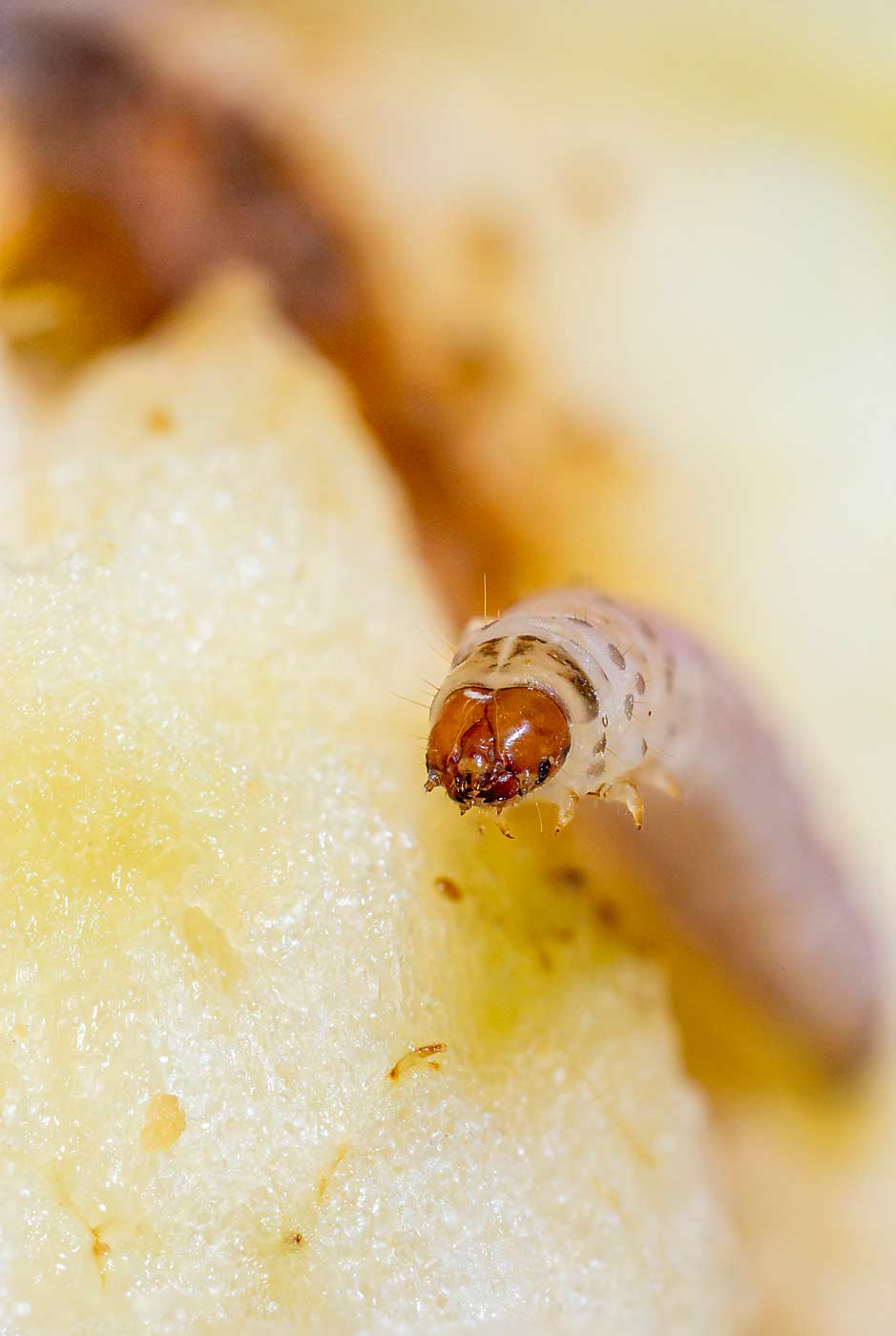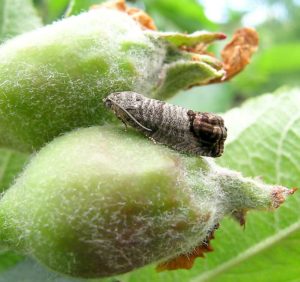
Earlier this year, in response to rumblings from the apple industry that codling moth needs more research and extension attention, a task force formed.
The first order of business: Try to figure out what the problem is.
It’s complicated, because some growers say they continue to get excellent control with traditional tools, while others increasingly report challenges. Theories for this disconnect abound: Perhaps the increase in organic management is driving changes across the region, or some growers may be paying the price for cutting rates to cut costs, or the moths themselves are developing resistance to trusted control practices.
“Codling moth is the key insect pest in apples,” said Mike Doerr, key account manager at Wilbur-Ellis and member of the new task force’s leadership committee. He believes the current challenges stem from a mix of aging technologies offering waning effectiveness and economic challenges leading to abandoned orchards or growers trying to reduce inputs — creating cracks in the management armor. “If you couple aging technologies with a downturn in the ag economy, you will see pest resurgences.”
Or as David Epstein of the Northwest Horticultural Council puts it: “You never solve a pest problem; it evolves.”
Pests such as codling moth require constant diligence, Epstein and Doerr said. The hope is that the new task force, which includes research, extension and industry voices, will bring more attention and new advances to the handling of this old foe. First, they have to figure out where to focus their attention.
“We’re trying to take the temperature of the situation, because there does seem to be a disagreement with some people saying we have the tools, people just need to use them properly, and others saying something is changing with the pest or the practices,” said Louis Nottingham, a Washington State University entomologist and, like every source in this story, a member of the task force’s executive committee.
Nottingham points to another possibility: a proliferation of new tools and approaches developed by suppliers in the absence of an independent authority to evaluate them all, since WSU’s Jay Brunner retired in 2015. Though many of the industry’s entomologists trained with Brunner and helped commercialize mating disruption, including Epstein, Doerr and Michigan State University’s Larry Gut, who then mentored Oregon State University’s Chris Adams, no one in Washington picked up the mantle of moth authority.
“Because codling moth was ‘under control’ (e.g., well managed) for many years, there hasn’t been the same emphasis on research and extension to manage this pest,” said Adams, an entomologist at OSU’s Hood River station. “In the absence of those reminders, growers begin to wonder: ‘Am I still doing it right?’”
That’s one of the questions the task force has, too. So, with input from warehouse field reps and chemical consultants, they designed a survey to ask growers how they are managing their codling moth, if they are struggling to get good control and how they define good control, along with where they want to see more research and extension efforts.
About 175 growers responded, representing a good mix of organic and conventional acreage, said WSU Extension specialist Gwen Hoheisel. At first pass, there’s no single easy diagnosis that jumps out as the root of the problem.
“We thought perhaps organic growers would stand out as really struggling, but only 30 percent of organic growers said the damage was unacceptable,” Nottingham said.
In fact, only a quarter of all respondents said their codling moth challenges were getting worse, Adams said. That’s the good news. Just over a quarter said it’s decreasing, while 36 percent said it’s unchanged and another 11 percent said it varies.
So, the task force will take a deeper dive into analytics with a statistician to look for the weaknesses in the system and who is experiencing them. For example, maybe people with older architecture and dense canopies who also use low pheromone rates are reporting worsening problems, Hoheisel said. Or perhaps people who drive their sprayers too fast are finding less efficacy with their cover sprays. It should reveal the cracks in the armor, in Doerr’s analogy, allowing the codling moth to come back strong.
“On a broad scale, I think this will really inform our research and extension efforts,” said WSU entomologist Betsy Beers. “The big picture is that there are at least some people who feel that the damage is unacceptable (or that any damage is unacceptable), reinforcing the notion that codling moth is a major pest.”
Attention deficit
Washington’s apple landscape has changed a lot since the commercialization of mating disruption ushered in some “golden years.” The industry has more organic acreage, more variations in management, more pheromone dispensing options, more lures for trapping and more apps to recommend timings, Adams said.
“There’s no one-size-fits-all problem, so there is no one-size-fits-all solution,” he said. And it takes time and funding to evaluate emerging tools. “We’re not going back to everyone managing codling moth in the same way.”
Nor do we need to, Beers said. Yes, the landscape is a patchwork of organic and conventional practices, new tech and traditional approaches, but that doesn’t seem to be driving the challenges some growers report.
“For the most part, the problem in your block is your problem — or if it wasn’t originally, it likely will be eventually,” she said. “If a codling moth is happy, it’s not going to fly that far from home, and it takes a concerted effort to clean up an established population.” Point-source problems, such as an abandoned orchard next door or infested bins, however, do occur, she added.
Will the solution to those problem blocks come from a refocus on the basics or new tools and technologies? Both, sources said.
“I think the first talk I ever gave at the Hort meeting, I stressed the importance of timing and coverage,” Beers said. “We do need to get back to those basics. At the same time, pest systems are dynamic, and we need to make sure we are out in front of that change, not behind.”
That leadership, to keep the industry ahead on codling moth, has been missing at WSU in recent years, task force members said. But they are optimistic that will soon change, as the university has formed a hiring committee to search for an endowed entomologist, supported by the tree fruit industry. Beers, who chairs the search committee, said it’s exciting to see the vision of the people who set up the endowment efforts, 10 years ago, finally bearing fruit.
Meanwhile, the task force can get a head start driving the conversation. They plan to hold a workshop to engage with the industry next year, as well as set new research priorities and seek new grant funding.
“I want to make sure that we provide growers scientifically vetted and accurate information to make good data-driven decisions,” Doerr said. “It is my hope that the task force can keep the importance of this pest elevated in the manufacturer, technology and research world so that folks continue to invest in new codling moth control tools and techniques.”
—by Kate Prengaman







Leave A Comment